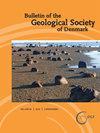长鳍银鱼是丹麦始新世富尔组最丰富的鱼类。
IF 1
4区 地球科学
Q2 Earth and Planetary Sciences
引用次数: 0
摘要
硬骨鱼是丹麦北部始新世早期Fur组中最具代表性的大型化石之一。该地层中最丰富的鱼类从未被正式描述过,尽管它在整个地层中都很丰富,只被称为“阿根廷类”。本文对该阿根廷类分类群进行了分类研究,并将其命名为Surlykus longigracilis gen. et sp. 11 .尾骨显示出第一脊膜中央和第一脊膜中央的分离,这在阿根廷目中是独一无二的。此外,它的特点是有一个大嘴和一个上腋窝,这表明Surlykus gen. nov.在阿根廷亚纲中处于基部位置,代表了该分支的所有其他谱系([阿根廷亚纲科+ Opisthoproctidae] + [Bathylagidae + Microstomatidae])的姐妹群,因此,它是阿根廷亚纲的茎群。大量死亡组合可能表明,长形苏利库斯(Surlykus longigracilis gen. et sp. 11)在古北海盆地形成了大型鱼群,它可能代表了古北海盆地鱼类群落的营养核。本文章由计算机程序翻译,如有差异,请以英文原文为准。
The argentiniform Surlykus longigracilis gen. et sp. nov., the most abundant fish from the Eocene Fur Formation of Denmark.
Bony fishes are among the best represented macrofossils from the earliest Eocene Fur Formation, northern Denmark. The most abundant fish of the formation has never been formally described, in spite of its abundance throughout the formation, and only referred to as an ‘argentinoid’. This work provides a taxonomic study of this argentinoid taxon, which is described herein as Surlykus longigracilis gen. et sp. nov. The caudal skeleton shows separated first preural and first ural centra, a unique condition within the Argentiniformes. In addition, it is characterised by having a large mouth and a single supramaxilla, which suggest that Surlykus gen. nov. occupies a basal position within the Argentiniformes, representing the sister-group to all the other lineages of this clade ([Argentinidae + Opisthoproctidae] + [Bathylagidae + Microstomatidae]), and, consequently, a stem-group Argentiniformes. Mass-mortality assemblages may indicate that Surlykus longigracilis gen. et sp. nov. formed large schools in the ancient North Sea Basin, where it probably represented the trophic nucleus of the fish communities.
求助全文
通过发布文献求助,成功后即可免费获取论文全文。
去求助
来源期刊

Bulletin of the Geological Society of Denmark
GEOSCIENCES, MULTIDISCIPLINARY-
CiteScore
2.80
自引率
16.70%
发文量
28
审稿时长
>12 weeks
期刊介绍:
The Bulletin publishes contributions of international interest in all fields of geological sciences on results of new work on material from Denmark, the Faroes and Greenland. Contributions based on other material may also be submitted to the Bulletin if the subject is of relevance for the geology of the area of primary interest.
 求助内容:
求助内容: 应助结果提醒方式:
应助结果提醒方式:


